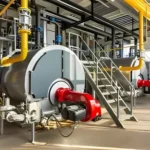


Neutralization is a chemical process for separating the free fatty acids from oils using Caustic.
The neutralized oil is to be washed before bleaching to separate any traces of soap or acid from oil.
After washing, the oil is vacuum dried to remove any water traces.
Degummed oil after conditioning is fed into the mixer where it is mixed with calculated quantity of caustic soda solution of suitable strength. Free fatty acids in the oil react with caustic soda to form soap. The mixture of oil and soap along with the precipitated gums is fed into a Centrifuge/Seperator to separate oil and soap stock.
Washing & Vacuum Drying
Neutralized oil produced from the separator still contains soap and needs to be washed. Hot water is added to the neutral oil and mixed in the mixer. The washed water and neutral oil are separated in the Seperator. The washed oil from separator is dried continuously in the vacuum drier.




The main purpose of bleaching is to remove coloring matters by absorption to obtain finished product with the desired color, on the other hand, for conventional refining, bleaching serves also to eliminate traces of soap before oil is passed to the final stage of deodorization.
The degummed/neutralized oil is first heated to desired temperature and then bleaching earth is added in adequate quantity controlled by PLC into the Oil – Earth mixer under vacuum.
This mixture of oil and earth is then pumped to Bleacher where it is agitated by open sparge steam and uniform bleaching takes place.
This is then transferred to Pressure leaf filters where the spent earth ( Cake) is separated and filtered again by passing oil through polish filters.

Deodorising is the final stage of the refining process and it is used to free the bleached/dewaxed oil from odoriferous material, free fatty acids and other minor impurities present.
Veendeep Oiltek’s special Deordorisation plant processes bleached oil to give superior quality odorless, colorless, bland oil with good shelf life.
The bleached oil is first pumped into Deareator where entrapped air if any is removed. The oil is then heated in vacuum final heater to the required deodorizing temperatures with the help of high pressure steam/ Thermic Fluid heating system.
The oil flows into the trays of the Deodorizer along longitudinal channels. Sparge steam pipes are installed in each compartment for intimate mixing of the oil and the steam.
The oil then flows to subsequent many deodorizing trays and then finally enters into the heat recovery tray.The oil is then cooled in the heat exchanger .
The deodorized oil then passes through a set of polish filters for storage.
The fatty acids and other components pass through large ducts and are condensed in special condensing section by means of fatty acids circulating at low temperature.
Corporate office:
Plot No. N-16/17/18, Additional MIDC Patalganga,